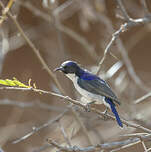Eastern Violet-backed Sunbird
Anthreptes orientalis - Souimanga du Kenya
Identification
The Eastern Violet-backed Sunbird of Kenya has a different look from most sunbirds. It has a disproportionately larger head, longer tail and shorter bill. It looks somewhat like a warbler. It shows a very distinct sexual dimorphism. The male has very dark, almost black upperparts with violet reflections on the hooded head, back, shoulders and tail. The wings are more brown. The lesser coverts tend towards iridescent blue. The underside of the body is white from the middle of the throat to the undertail coverts. The flanks are grayish. It is reputed to have yellow throat tufts but these are rarely visible. The black bill is short (equal to the distance between the front and the eye), fairly thick and slightly curved. The iris is brown. The legs are black. The female is less contrasted. The upper body and head are a relatively cold brown-grey. The wings are a little darker. A distinct white eyebrow runs from the bill to the nape. From the male, she only retains the violet tail and undertail coverts. The underside, from the bill to the tail, is white, often shaded with yellow. The juvenile is similar to the female with a darker upper part and a yellower underside.
Subspecific information monotypic species
Foreign names
- Souimanga du Kenya,
- Suimanga keniata,
- nectarínia-de-rabadilha-turquesa,
- Schwalbennektarvogel,
- kenyai nektármadár,
- Zwaluwhoningzuiger,
- Nettarinia dorsoviola del Kenya,
- törnsolfågel,
- Tornsolfugl,
- nektárovka savanová,
- strdimil vlaštovčí,
- Østafrikansk Solfugl,
- violettimedestäjä,
- suimanga de Kenya,
- nektarzyk sawannowy,
- Ласточковая короткохвостая нектарница,
- ヒガシスミレコバシタイヨウチョウ,
- 东紫背食蜜鸟,
- törnsolfågel,
- 東方紫背直嘴太陽鳥,
Voice song and call
Habitat
Behaviour character trait
Dietfeeding habits
Reproduction nesting
The Eastern Violet-backed Sunbird's nesting takes place year-round, though the period may vary depending on the country.
The nest is suspended on the end of a thin branch of a bush, sometimes close to wasp nests. It is oval shaped with a lateral entrance that has a small roof to protect it. It is woven mainly with dry herbs, intertwined filaments, wool and hairs, and lined with kapok inside. The Eastern Violet-backed Sunbird has the particularity of adorning its nest with old mantid oothecae that it attaches to the branch. The female lays one or two greyish-green eggs with dark grey or brown spots. There are no data on the incubation period nor feeding time but if we follow other sunbird species, the female can incubate around ten days and the feeding around two weeks.Geographic range
The Eastern Violet-backed Sunbird is found and breeds in the Sudan, Ethiopia where it is common. It is also fairly common in southern Somalia and locally common in the northwest. It is a locally uncommon resident in Kenya and Uganda. There is no known migratory movement today for this taxon.
Threats - protection
Sources of information
- IOC World Bird List (v15.1), Gill, F and D Donsker (Eds). 2025-12-07.
- Sunbirds, Roberts A. Cheke, Clive F. Mann and Richard Allen
- BirdLife International, BirdLife International
- HBW Alive,
Other sources of interest
 Specification sheet created on
22/07/2023 by Nathalie Santa Maria
Specification sheet created on
22/07/2023 by Nathalie Santa MariaTranslation by AI Oiseaux.net
© 1996-2025 Oiseaux.net
- Accipitriformes
- Aegotheliformes
- Anseriformes
- Apodiformes
- Apterygiformes
- Bucerotiformes
- Caprimulgiformes
- Cariamiformes
- Casuariiformes
- Charadriiformes
- Ciconiiformes
- Coliiformes
- Columbiformes
- Coraciiformes
- Cuculiformes
- Eurypygiformes
- Falconiformes
- Galliformes
- Gaviiformes
- Gruiformes
- Leptosomiformes
- Mesitornithiformes
- Musophagiformes
- Nyctibiiformes
- Opisthocomiformes
- Otidiformes
- Passeriformes
- Pelecaniformes
- Phaethontiformes
- Phoenicopteriformes
- Piciformes
- Podargiformes
- Podicipediformes
- Procellariiformes
- Psittaciformes
- Pterocliformes
- Rheiformes
- Sphenisciformes
- Steatornithiformes
- Strigiformes
- Struthioniformes
- Suliformes
- Tinamiformes
- Trogoniformes




























